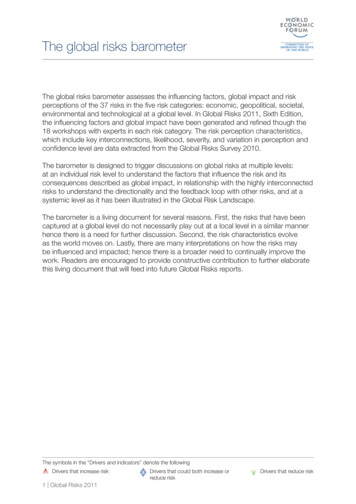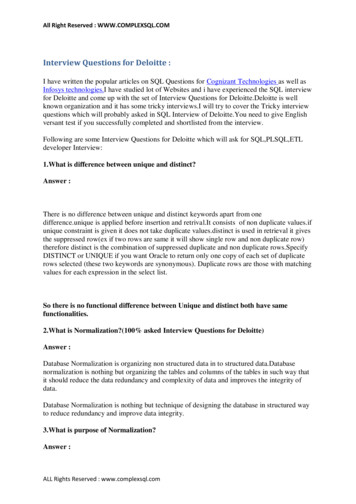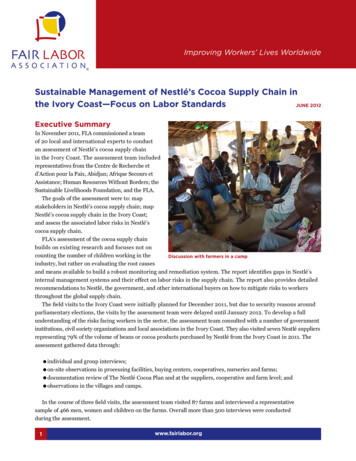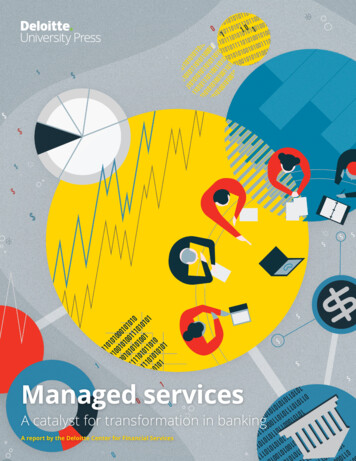
Transcription
Headline Open Sans Boldlonger headline nsare a SansdifferentSubheading OpenLightadventureSubtitle or dateJune 2017 date or author second linesubtitle,
An interesting dilemmafor those legacy financialinstitutions consideringbuying into Fintech; howto best structure theacquisition and integrationof these companies in a waythat enables their growth,while effectively managingtheir inherent risks?
In recent years, Financial Technology companies have emerged as an attractive growthalternative in an otherwise slow growth environment. The combination of native digitalproducts, nimble operating model, and customer-oriented mindset has not only caughtthe eye of an early-adopter consumer base and a tech-savvy millennial workforce; butalso attracted attention from Private Equity and established financial institutions lookingfor investments in high growth areas. The volume of acquisitions involving Fintechcompanies normalized in 2016, retreating from the record highs seen in 2015,1 with totaldeal volume totalling 13.7B, down 66% YoY. This decrease was due primarily to greatlyreduced number of transactions valued over 1B, which accounted for over 90% of dealflow in 2015 . Transaction volume in the space continues to be driven by volume belowthe 1B mark, as Fintech companies continue to receive attention from buyers bothwithin financial services and as pure investment plays for private funds. This incrediblegrowth is indicative of the attention these companies are receiving from buyers bothwithin financial services and as pure investment plays for private funds. Which bring usto an interesting dilemma for those legacy financial institutions considering buying intoFintech; how to best structure the acquisition and integration of these companies in away that enables their growth, while effectively managing their inherent risks?Source: SNL Financial-M&A Market Data, http://www.snl.comNote: Total deal volume and number of transactions based on disclosed deal values.1
Due to the disruptive and technology-forward nature of Fintechs,effectively integrating a Fintech start-up — or even a moreestablished player – presents an entirely new set of potentialchallenges, even for the most M&A-savvy financial institution. Thesechallenges, from clearly understanding what are actual productsand capabilities versus ‘vapor-ware’, to preventing talent flight andmaintaining growth trajectory despite operational friction, oftenresult in many Fintech acquisitions failing to meet their statedobjectives. But Fintechs are disrupting traditional financial servicesdue to these differences and any FSI firm looking to harness thisdisruption should account for what makes these nimble newcompanies unique in their integration strategy.3 TransformativePreserveand retainEmerging2 AdjacentExistingHow-to-win (capabilities)NewProximity to Buyer’s Core Businessshould determine integration strategyAn acquirer’s approach to due diligence should be informed bya target’s proximity to their core business. The space between atarget’s business model and the buyer’s will have an outsized effecton the ease and success of a potential transaction and integration;the due diligence process should reflect this. While an acquirer maybe comfortable managing the diligence process for a target in thesame industry, it may prove necessary to enlist relevant subjectmatter advisors when evaluating Fintech targets.Furthermore, thetarget operating model envisioned for a potential Fintech acquisitionshould directly inform the due diligence process and inputs. A buyershould know which of the two operating models, a holding companymodel versus capability acquisition, best suits their overall Fintechstrategy and structure their due diligence accordingly.In our experiences advising clients in these types of transactions, wediscovered a number of critical factors that can significantly enhancean organization’s ability to protect the sources of value and to realizethe full potential of their investments.1 CoreAggressiveassimilationExistingcomplexity that merits significant investment in appropriate duediligence of the target’s financials, commercial business strategy,risk practices & regulatory compliance, operations, technology, andhuman resources.Talent re-to-play (market opportunities)Aggressive assimilation vs preserve and retainTwo primary strategies of harnessing innovative Fintech areemerging in the marketplace that reside at opposite ends of a slidingscale of integration. The first is a capability driven strategy whereinestablished FSI firms seek to acquire and integrate new products,channels, or capabilities into their existing business portfolio to fill agap and/or prepare for a potential market shift. The second adheresmore closely to a holding-company model where the acquiringinstitution builds a portfolio of Fintech companies that continueto stand on the strength of their respective business cases whileleveraging the scope and scale provided under the umbrella of theparent company.Either of these strategies represents a viable path for anorganization seeking to harness the innovation potential of newFintech companies. And while the factors that should be consideredin order to achieve integration of a Fintech into a more traditionalfinancial services firm are consistent in both, the focus of each willshift depending on the strategy the acquirer has chosen to pursue.Mature Fintech companies are also turning to acquisition as strategyto drive growth; this piece, however, will focus on challenges facingtraditional FSI organizations considering acquisitions as a path toacquiring new capabilities or building a Fintech portfolio.Doubling down on due diligenceDespite their relatively small size, Fintech start-ups may be builton business models and technology platforms that are unfamiliarto legacy financial institutions. As such, they typically present ntaininggrowthmomentum1. Product, product, product An in-depth understanding of theirtarget’s complete product lifecycleand where in that lifecycle productscurrently lie is paramount. This willnot only allow acquirers to betterassign a value to the products andcommercial business practices theyare seeking to integrate, but alsomore accurately forecast resourcesneeded to support acquired products post-integration so thatthey do not “get lost in the crowd” in a much larger institution. Thisintelligence gathering should begin with a clear view into exactlywhat specific customer behavior or market niche a potential targetis addressing. Product due diligence should be extended deep intoa target’s product roadmap or pipeline to gain visibility into whatfuture functionalities, product enhancements, or blue-sky projectsare “in-flight or planned” and what additional resources will berequired to execute.
2. Engaging and retaining talentTalent is often a primary valuedriver in a Fintech acquisition. Manyemployees of a target may havejoined these companies becausethey believed they were signing upto reshape an industry and now theymight be joining the very firms theywere trying to disrupt through nodecision of their own. Beyond thischange in mission, buyers should also address potentially radicaldifferences in office culture and work environment, compensation,and attitude toward rules, risk, and regulation. For a firm attemptingto build out capabilities through acquisition, finding a way tomaintain this culture post-integration is key to helping prevent thetalent flight that can often follow these transactions.Culture can encompass elements from talent acquisition and talentmanagement, how roles and responsibilities are defined, to howcompensation is structured and are likely to be vastly different inFintechs versus traditional financial services companies. Specialattention should be paid to the titles given to newly integratedemployees to ensure they accurately communicate their new roleand seniority to the greater parent organization. Even the physicalspace in which newly integrated employees are located should beconsidered a critical element to be accounted for both pre and postintegration. These softer aspects of integration planning can be keyfactors in retaining the very talent that made a Fintech companyan attractive target and acquirers should seek ways to adapt theirorganizational structure to enable said talent to integrate, grow, andinfluence the organization.A high priority consideration for FSI firms integrating a start-upcompletely into the parent company, cultural alignment andintegration should not be discounted by firms following the holdingcompany model, especially if any newly acquired Fintech companieswill be co-locating with the parent.3. Operating model frictionThis culture shock can also posenew challenges operationally.Fintechs and their employees maybe accustomed to more freedomaround their technology (e.g. BringYour Own Device, use of publiccloud storage, emphasis on remoteworking, open source code) than iscustomary in traditional financialinstitutions. Integrating these new employees into a more controlledenvironment, one heavily governed by regulation and securitypolicies, can pose a serious roadblock to productivity. FSI firms maywant to examine carving out a new technology policy specificallyfor acquired Fintech firms that accounts for these differences andallows for continued technological flexibility while adhering to anyregulatory requirements and permits new employees to interactwith the rest of the company.Firms should also consider how governance models should bestructured to allow an acquired Fintech to continue to be nimblein delivering products rather than trying to force fit an existingapproach for development and release of new products. Many newFintechs may use Agile or Lean methodologies that, while widelyused and understood in the technology sector, may not mesh wellwith a traditional FSI firm’s existing IT or Legal and Compliancefunctions. For those firms adding capabilities through acquisition,stakeholders on both sides of the transaction should be well briefedon expectations for engagement moving forward. Understandinghow these two models differ and establishing a model forgovernance and interaction that addresses those differences whileenabling the Fintech to continue innovating is critical to achievingvalue in such a transaction.4. Ringfence revenueIn any transaction undertaken todrive growth it is important notto lose sight of what the majordrivers of revenue are and assesswhether they are not at risk. Thisis especially true in the case ofa traditional financial institutionseeking to expand its reach throughan acquisition of a start-up. Earlystage companies are often single-minded in their drive for growth asa necessity and integration into a larger organization may dull thatedge as time and resources are pulled to activities such as buildingcompliance specs away from market-facing activities. Ringfencingrevenue drivers can help the teams maintain their focus on revenueeven as they integrate.This continued focus on a Fintech’s revenue trajectory is typicallyof greater importance to an FSI firm following the holding companystrategy as each company acquired will likely have to prove ongoingvalue as a standalone business. For those institutions seeking tofold in new capabilities, the due diligence process should account forthe shuttering of independent revenue streams as acquired teamsare absorbed into the parent. Lastly, acquirers should be sure tounderstand any regulatory constraints or legal entity implicationsthat may require the shutting down of any revenue streams priorto acquisition to ensure the chosen integration strategy, be itassimilation or preserve and retain, aligns with regulations.Acquirer’s dilemma — creating the right environmentFor FSI companies looking to harness the disruptive power Fintechis introducing to the market, it is clear that the very factors thatdifferentiate these acquisitions from traditional transactions areoften what have allowed these Fintech companies to be successfulthus far. Much of the success or failure of a legacy firm’s M&Aapproach to Fintech acquisition hinges upon its appetite for enablingthe operational transformation necessary to create an environmentinside the firm where newly acquired and integrated Fintechcompanies can continue to innovate with as little friction as possible.Barring this, it may better to follow a holding company strategy andallow each acquired company to continue along its own path togrowth.
AuthorsMaximilliano BercumSteve MahoneyAustin KairisPrincipal, Miamimbercum@deloitte.com1 678 640 7367Senior Manager, New Yorksmahoney@deloitte.com1 646 276 5320Senior Consultant, New Yorkaukairis@deloitte.com1 917 891 7351About DeloitteAs used in this document, “Deloitte” means Deloitte Consulting LLP, a subsidiary of Deloitte LLP. Please see www.deloitte.com/us/about for a detailed description of our legal structure. Certain services may not be available to attest clients underthe rules and regulations of public accounting.This communication contains general information only, and none of Deloitte Touche Tohmatsu Limited, its member firms,or their related entities (collectively, the “Deloitte Network”) is, by means of this communication, rendering professionaladvice or services. Before making any decision or taking any action that may affect your finances or your business,you should consult a qualified professional adviser. No entity in the Deloitte Network shall be responsible for any losswhatsoever sustained by any person who relies on this communication.Copyright 2017 Deloitte Development LLC. All rights reserved.
disruption should account for what makes these nimble new companies unique in their integration strategy. Aggressive assimilation vs preserve and retain Two primary strategies of harnessing innovative Fintech are emerging in the marketplace that r










